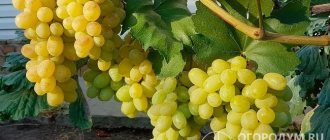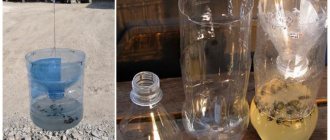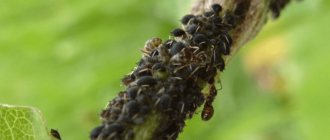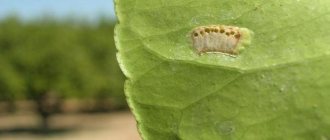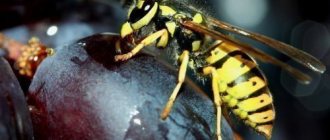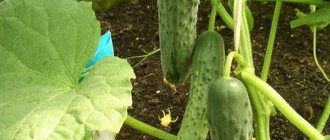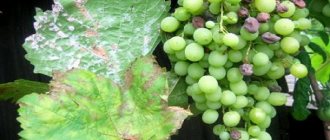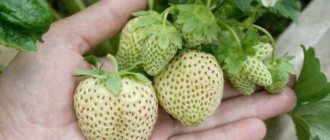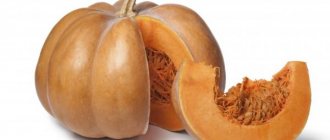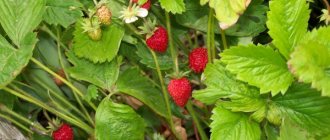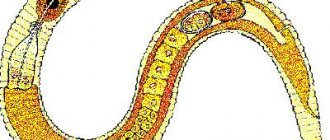Many people love table grapes - they are healthy, beautiful and tasty. It’s just that it gets boring picking out the bones. There is a solution - plant raisin grapes in the garden. Kishmish is the name given to grapes with underdeveloped seeds or completely devoid of them. Translated from Arabic, “quiche mish” means “dried grapes.” This is a natural mutation of ordinary grapes, selected and enhanced by man. The first varieties of sultanas appeared in Central Asia. Kishmish is grown for making raisins and as a dessert fruit. Juices and wines with good taste are also obtained from it.
Kishmish is the name given to grapes with underdeveloped seeds or completely devoid of them.
Kishmish grape varieties contain more sugars compared to regular ones. Being seedless makes sultanas a desirable delicacy; even small children can eat them.
Nutritional value
Dried grapes are tasty and nutritious, quickly making you feel full. 100 g of raisins contains:
- 8275 calories
- a quarter of the daily value of fiber - dietary fiber
- 762 mg potassium
- 0.3 mg copper
- 22 mg iron
In addition, sultanas contain folic acid, vitamins C, B12, and many other microelements. Grapes are useful for kidney and gastrointestinal diseases, osteoporosis, anemia, neuroses and depression. Has a choleretic effect. Potassium is essential for preventing heart disease. Diabetics should use sultanas with caution - they contain a lot of glucose. It is undesirable to eat raisin grapes during exacerbations of gastritis and stomach ulcers. It is useful during the recovery period. How to plant raisin grapes
Rules for planting young seedlings
Kishmish grapes, depending on the variety, can be more or less capricious, but in general, planting and caring for any variety requires compliance with the same rules.
Optimal time
Vines, like trees, can be planted in spring or fall. Each method has its supporters.
Of course, autumn planting is good because a minimum amount of time passes between the time of digging up the seedling and the moment of planting, because it is unknown how the seedling will survive long-term storage during the winter; the risk of death here is quite high.
On the other hand, if the winter turns out to be too harsh, there is a high probability that the poorly strengthened and not fully rooted seedling may not withstand the frost and die. Some winegrowers, having acquired a particularly rare variety of vine on occasion at a time when the ground has already begun to freeze, manage to plant grapes even in winter, choosing a particularly warm day with above-zero temperatures, so as not to expose the seedling to the risk of long-term storage and subsequent unpredictable planting results.
If you prefer spring planting, wait for stable warmth and the final disappearance of night frosts. The optimal time is from April 20 to May 20.
In autumn, planting is carried out in October or even later, but, of course, it is necessary to have time before frost. To prevent the seedling from freezing, you can cover it with a plastic bottle or dig it in with pine paws or peat.
Selecting a location
Wine berries love warmth and a lot of light, so if you don’t have such a place on your site, it’s better to choose another crop to grow. Also, you should not plant grapes in close proximity to a house or other buildings from the west or east, since during one or another part of the day in this case a shadow will fall on the vine and the berries will not ripen as expected.
Trees are bad neighbors for grapes : in addition to providing unnecessary shade, they interfere with the development of the root system of the vine, suppressing it with their roots.
Did you know? If you plant grapes on the south side of a permanent structure or wall, the vine will be protected from the north wind and, in addition, will receive additional heat from the heating surface.
The roots of grapes are located at great depths, therefore, when choosing a place for planting, you need to make sure that there is no high groundwater in this place or make layering, otherwise the roots will rot and the grapes may die. You should not plant the vine near a cesspool or fire pit, as grapes love clean soil. Also, this plant does not tolerate dust well, so you should also try to protect the planting from the road.
The ideal place for wineberry bushes is a southern slope (the southwestern side of the hill is also suitable). The distance between seedlings should be at least two meters.
Step by step planting process
We dig holes 0.7 m deep, 0.4 m wide, 0.8 m long (the long part of the hole should be located from north to south).
At the bottom of each hole we place a layer of ash and superphosphate, then a drainage layer (fine gravel, crushed stone, expanded clay, etc.).
Next we place the soil mixture in the hole: sand, humus and fertile soil.
On the south side of the pit we install any pipe (for example, rubber) with a diameter of at least 5 cm and a length of about a meter (the end of the pipe should rise above ground level by at least 5-10 cm. We strengthen the pipe with gravel, sprinkle it with earth and tamp it down well.
To the north of the pipe, at the bottom of the hole, we pour a small mound of fertile soil, in the center of which we place a seedling, slightly tilting it away from the pipe to the south. We fill the hole.
Important! When planting a seedling, two buds should remain underground, the rest on top. The upper two eyes can be trimmed immediately after planting, this will speed up the growth of the bush.
We water the seedling. Watering the grapes with this technology will be carried out directly through the pipe, so the moisture will easily reach the roots of the vine.
Landing on time
Kishmish can be planted in both spring and autumn
Kishmish can be planted in both spring and autumn. Autumn planting is more often used in the southern regions. Usually planted in early October, when there is no threat of frost. For the winter, the seedlings are well insulated: a mound of soil is poured, and the top is covered with film or other protective material. In the northern viticulture zone, autumn weather is unreliable, so it is better to plant grapes in the spring. Dates vary from late April to late May. Dormant seedlings are planted before buds open, when the soil warms up to 10–12°C. Green seedlings rooted in containers can be planted in June.
How to choose the right grape seedlings when purchasing
There are several universal rules for purchasing any plant material. First , it is very advisable to buy goods in a trusted place: ideally, from a familiar farmer (who will also give you all the necessary recommendations and answer all your questions) or at least in a trusted store (preferably a specialized store, not a supermarket), or an Internet site.
Another good tip is to take a specialist with you who will make the choice for you and protect you from making the wrong purchase.
If you have to make a choice yourself, use the following tips:
- There is no need to buy seedlings with dried out roots (if your grandmother is standing on the road in the open sun and selling dug up vines, drive by with confidence , you are unlikely to be able to revive such grapes).
- If you are going to plant grapes in the fall, do not buy seedlings with leaves : when digging up a seedling, the leaves need to be cut off, otherwise the bush will quickly dry out and then may not take root.
- You need to purchase seedlings only in season : if in the entire bazaar you see only one seller who was the first to “grow” the goods for planting, think about what methods he used to make the vine look formed. In addition, storing a seedling for a long time before it is time to plant it in the ground is also a big risk that the grapes will not take root . Buy on time and plant immediately!
- Ask the seller to cut off the “head” of the seedling a few millimeters or carefully scrape off a small section of bark to make sure that the vine is alive (the seedling should have green and slightly moist flesh when cut). You also need to check the roots of the seedling by cutting off a small tip and carefully examining the cut - at a living root it is light and moist, similar to a potato cut in half, at a dead root it is dry and dark.
- Gently bend the vine : it will break when dry (a slight crack when bending is normal). Lightly press the eyes on the seedling with your finger - they should not break off.
- Check whether the seedling's graft has taken root: take it with one hand above the graft, with the other below, and gently twist it, as if you want to wring out laundry. The fusion must be absolute - no cracking , no gaps should appear at the grafting site.
Kishmish grape planting technology
To plant a seedling, dig a hole 60-70 cm deep and wide, pour drainage - broken brick or coarse gravel - into the bottom. They dig in a support. Add a shovel of ash and a glass of superphosphate. Next, the hole is filled with a mixture of soil and humus. A deep hole is made for the seedling and planted at such a depth that there are 2 eyes remaining above the surface of the hole. The hole is spilled with warm water and the ground is mulched. In the first year, the shoots of the seedling are tied vertically to the support and only in subsequent years they are given an inclination according to the chosen shape.
What is the minimum distance between grape bushes?
Strongly growing varieties on fertile soils are planted at a distance of at least three meters from each other, and the row spacing is 4-5 meters. For low-growing varieties, the distance between the bushes can be left 2.5 meters or even 2.3, this will be quite enough for them.
Interesting materials:
What do class leaders do? What do you do with a broom in a bathhouse? What did the king of the night do with the babies? What did the council of ministers do? What to do to prevent candy melts? What to do if Safe Search does not turn off? What should the bow do? What to do at an appointment with a neurologist? What to do after purchasing an electronic plane ticket? What to do with large soft toys?
How to care for sultanas
- Grape pruning. Most often, sultanas are cut off, leaving 8–12 eyes on the vine. Remove weak and unnecessary shoots. The load in clusters must be normalized. For each shoot, 1–2 large clusters are left, the rest are removed.
- In hot weather, abundant watering is required every 3-4 days. The amount of water depends on the soil, on average 2-3 buckets of water per bush. Two weeks before harvest, watering is halved to prevent cracking of the berries.
- Feeding is applied sparingly. In spring, nitrogen fertilizers, including organic ones, are appropriate. It is better to add liquid fertilizers when watering. By mid-summer, nitrogen fertilizing is stopped; phosphorus and potassium are needed for the ripening of vines and berries at this time.
- It has been noted that the stimulant gibberellin increases the size of berries and the density of sultana clusters. The drug “Ovary” is produced for summer residents. They spray grapes during flowering.
- Treatment against diseases and pests. Kishmish grapes need the prevention of fungal diseases. In spring and autumn, Bordeaux mixture or copper sulfate is used, in the summer - complex preparations Ridomil Gold, Strobi. Sometimes insecticides are used, for example, in the case of spider mites. During the ripening period, raisins are protected from wasps using special bags or fumigation with smoke.
Choosing a variety is an important matter. Over the long history of cultivation, various varieties of sultanas have been bred. Eastern Central Asian varieties are heat-loving; in most regions they do not ripen and freeze out. However, raisins have been bred that are suitable for cultivation in the regions of Russia.
Over the long history of cultivation, various varieties of sultanas have been bred
What varieties of sultanas are suitable for planting in the middle zone, the Ural and Siberian regions?
- Firstly, they are frost-resistant. There are varieties of sultanas with frost resistance down to – 23–28°C. Some varieties of Far Eastern and American selection can be grown as uncovered or as arbors. But in most cases, sultanas should be carefully covered in order to obtain a stable harvest.
- Secondly, sultanas that can ripen in the short northern summer. Kishmish varieties with a ripening period from very early to early-mid are suitable for growing in risky farming zones. In addition, ripening depends on the amount of positive temperatures during the growing season.
Methods for propagating seedless grapes
The absence of seeds does not become an obstacle to reproduction. In all varieties of this garden crop, regardless of whether it has seeds or without them, propagation occurs vegetatively - using cuttings or layering. Thanks to this method, it is possible to preserve all the qualities of a certain berry variety.
Seed propagation is used by breeders when it is necessary to develop new varieties. It is quite difficult to obtain new species from seedless varieties. To do this, breeders cross them with grapes that have seeds.
Thus, propagation of seedless grapes is no different from the methods in which other varieties of this garden crop are propagated. Grapevine propagation occurs vegetatively - by cuttings and layering.
If you find an error, please select a piece of text and press Ctrl+Enter.
Rusbol (Kishmish Mirage)
Rusbol grapes ripen within 115–125 days
Ripens within 115–125 days. The clusters are conical, large, and can reach 1 kg. The berries are white, oval, pleasant taste, and there are rudiments of seeds. The fruitfulness of the shoots is high, so the vines can be cut short to 2-3 buds. Overloaded with harvest, requires rationing. The cuttings take root well. Frost resistance -25°C, moderately resistant to grape diseases. Rusbol is suitable for drying and as a table variety, its disadvantage is the presence of seeds. Recently, the analogue variety Rusbol improved (Elf) has become more common.
Types and benefits of seedless varieties
In horticulture, two varieties of seedless grapes are grown - Kishmish and Russian Korinka. The first species is fertilized in the usual way, seeds are laid in its fruits, but their development stops in the early stages. The fruits of the second variety are set without pollination, so seeds are not formed.
Seedless grapes are a favorite among gardeners and consumers.
The first people like it because of its ease of cultivation, the second because of its special taste and ease of use. Seedless grape varieties have a rich taste and aroma. Interesting fact : black and white varieties of sultanas are used as raw materials for raisins and are actively used in the production of wines and cognacs. Corinka is also widely used in winemaking.
Kishmish Autumn Royal (Autumn Royal)
One of the largest-fruited seedless varieties. Kishmish was developed in the USA. Ripens late and is tested in the southern regions. The bushes are medium-sized. The clusters are large, weighing about 800 g. The berries are purple-black, weighing 6–8 g, thin-skinned. The taste is simple and harmonious. Resistant to frost down to -21°C, moderately resistant to diseases. The harvest is unstable. The quality of the berries depends on the load of the bush. Disadvantage - shedding of berries at the ripe stage. It is recommended to put covers on the bunches, which also protect the crop from wasps.
What is dried sultanas?
Kishmish is dried seedless grapes. Raisins - natural drying and not very drying. Over the past fifty years, traditional methods and technology for drying grapes have changed greatly. New, “ultrachemical” drying methods quickly and almost universally replaced natural ones.
Interesting materials:
Why open a deposit? What is the diaper for? What is stalked celery good for? What is magnesium sulfate powder for? What is the purpose of a computer presentation? Why were miniskirts invented? What is the App Store app for? What are authentication and identification used for? Why is Grandaxin taken? Why do you have a bachelorette party?
Einseth Seedlis
Seedless variety bred in the USA. Powerful tall bushes, can be grown on a gazebo. The variety is frost-resistant, like many descendants of “Isabella”. Ripens early. The clusters are small, 180–250 g, dense. The berries are pink or red, small. The skin is dense and can be removed with a “bag”. The pulp is juicy, with a characteristic strawberry “isabelle” aroma. Highly resistant to diseases. The berries are transportable, do not crack, and are suitable for eating and drying. Other popular varieties of American selection are Reliance Pink Seedlis, Red Flame, Neptune, Jupiter. Every gardener should plant a wonderful grape in his garden - sultanas!
How is Far Eastern lemongrass useful?
The beneficial and healing properties of the vine are due to its unique composition. The substances contained in the berries act on the body as a tonic and antioxidant, which in addition helps to strengthen its defenses. Vitamins and minerals. In lemongrass
high content of vitamins C and E.
Interesting materials:
How to prepare royal Pelargonium for winter? How to prepare red currant bushes for winter? How to prepare remontant raspberry bushes for winter? How to prepare honeysuckle bushes for winter? How to prepare lupine for winter? How to prepare young cherries for winter? How to prepare young blueberries for winter? How to prepare a greenhouse after winter? How to prepare the soil in a greenhouse for winter? How to prepare roses for winter at the dacha?
Diseases and pests
Productivity is lost due to diseases and pests. To prevent losses, timely prevention is needed.
Symptoms and measures to combat diseases and pests of Kishmish:
White rot
Initially, the ridge and stalk of the grapes are affected. Then the fungus spreads to individual berries, and then covers the entire bunch. The berries become lethargic, turn red and fall off.
Diseased vines become covered with round spots, edged with a black rim. In the affected areas, the bark is soaked. In damp weather, you can see the spores of the pathogen - dirty white dots.
They form on affected berries and areas of the vine. The problem most often appears after sunburn, hail, or mildew.
The disease is treatable; measures to combat it include spraying with a 4% solution of Bordeaux mixture, 5% Captan solution or 1% TMTD suspension.
Prevention:
- fulfillment of agricultural technology conditions;
- The pruning regime must be especially strictly observed so that the bushes are well ventilated and illuminated by the sun.
Gray rot
The disease can appear on berries at the very beginning of their formation. But the most affected are grapes that have begun to ripen or have already begun to ripen. The berries become covered with brown spots, the skin cracks on them, and a gray fluffy coating appears - sporulation of the fungus.
If the autumn is dry, then the fungus causes the berries to raisin, the so-called noble rot. Brushes affected by gray rot are not suitable for transportation and storage.
Unfortunately, there is no effective treatment for the fungus.
Therefore, all efforts should be directed towards preventive measures:
- timely breaking off and tying up shoots;
- thinning the leaf mass so that the berries have greater access to sunlight;
- At the first sign of damage, the entire crop should be immediately removed.
Rubella
The disease primarily affects the leaves. At the end of April - beginning of May, light spots appear on them, which then spread between the veins. On varieties with light berries, they become brown with a narrow waxy-yellow border.
On dark varieties, the color of the spots is bright burgundy with a yellow-green border. Affected leaves dry out and fall off prematurely. The consequence of rubella can be inhibition of the growth of shoots, inflorescences and ovaries.
The taste of the grapes may not change for the better.
If rubella appeared last season, then in the spring, as soon as the leaves begin to appear, spray 2–3 times with 1.5–2% Bordeaux mixture or 0.5% Zineb solution. The interval between procedures is 5 – 10 days.
Further treatment is the same as against mildew - 1% solution of Bordeaux mixture. Timely fertilizing and proper soil care will help reduce the risk of disease.
leaf roller
The leaf roller caterpillar damages buds, ovaries and berries. One caterpillar can destroy up to 50 buds. If the berries are damaged, then harmful microorganisms develop on them, leading to rotting, first of individual fruits, and then of the entire cluster.
For butterflies, baits are made in the form of containers hung among the bushes at a height of 70 cm from the soil surface.
Wine dregs, diluted 1/3 with water, are poured into the trap. Treatment with Vofatox (2.5 - 3 g of the drug per 1 m²) or Methylethylthiophos (15 g per 10 l of water) is used against caterpillars.
For the purpose of prevention, immediately after removing the winter shelter, you should peel off the old bark in which the pupae overwinter and burn it.
Wasps
These insects, attracted by the sweet taste of the berries, spoil their skin, making the grapes unable to be stored.
In addition, damaged berries undergo a rotting process, which extends to whole fruits. You can fight wasps in different ways.
This includes the use of pesticides, special traps and poisoned baits, and the destruction of nests. But if you consider wasps to be beneficial insects, then measures to combat them may not be so radical.
You can, for example, plant plants around the grape bushes whose smell is not to the taste of wasps - mint, lemon balm, basil. And in addition to this, put special protective bags made of tulle on the ripening bunches of grapes.
Kishmish instead of potatoes. An assistant professor grows 50 varieties of grapes at his dacha
GRODNO, September 7 – Sputnik, Inna Grishuk.
In Belarusian dachas, without any particular difficulties, you can grow sweet dessert grapes, which in appearance and taste are in no way inferior to bunches brought from hot countries. You just need to stock up on a little knowledge and follow simple rules of care.
Sergei Sobolev from Grodno, who has been developing the grape movement in the Grodno region for more than 15 years, is sure of this.
The Sputnik journalist was personally convinced of this. And residents of Grodno who want to grow not only pears and apples will be able to learn more about grapes at a specialized exhibition, which is being held at the Grodno Agrarian University on September 7 and 8.
Develops viticulture for 15 years
“In the early 2000s, when we started holding the first grape exhibitions, many had to be convinced that in Belarus, in principle, it was possible to grow sweet, juicy table grapes. People came, tried the berries and did not believe that they grew here,” recalls Sergei Sobolev, associate professor of the department of horticulture and fruit growing at the Grodno Agrarian University. He has been working on the grape topic for more than 20 years - in scientific works and in practice, as well as the development of viticulture in the Grodno region.
© Sputnik / Inna Grishuk
Associate Professor Sergei Sobolev has a grape paradise at his dacha; more than 50 varieties of sweet grapes grow here
Now the grape theme in the Grodno region is not as bad as it was 15 years ago. Visitors already know that it is indeed possible to grow sweet grapes in Belarus, so they come to exhibitions for information.
“Now like-minded people gather here. People come to the exhibition to learn about new varieties, exchange experiences, and learn the intricacies of caring for certain varieties. Some people want to find out how to start growing grapes, others want to choose a new variety,” the interlocutor adds.
© Sputnik / Inna Grishuk
You can even grow sweet sultanas in your dacha
According to him, there are also people in Grodno who have up to a hundred varieties of grapes growing on their plots, but out of modesty they prefer not to participate in exhibitions.
50 grape varieties at the dacha
Associate Professor Sobolev himself knows about grapes not only theoretically. He has been growing sweet berries for many years. The first vine at the dacha was planted by my parents in the early 90s. Now it has grown thickly near the entrance to the house. Sergei planted his first seedlings 10 years later, when he had already graduated from graduate school and written more than one scientific paper on grapes. At first there were two bushes, then - 10, now - more than 50 varieties, which are constantly updated.
© Sputnik / Inna Grishuk
Even in open ground you can get a good harvest, but tastier grapes will grow if you plant them in a greenhouse
The Sobolev family never buys grapes in the summer. He keeps so many varieties on the plot not only for the sake of experiments, but also to please the tastes of the whole family. Some of the berries are eaten, some are used for homemade wine.
At the Sobolev family’s dacha plot near Grodno, right from the gate you find yourself in a grape paradise - rows of wire are stretched along which the vines are woven, and green, golden, red and dark blue bunches are basking in the sun on the bushes. At least half of the territory here is devoted to grapes. The owner offers not only to watch, but also to try. Each berry, even the unripe one, tastes juicy, sweet, and seems more delicious than store-bought ones.
“It’s not interesting to grow sour grapes,” explains Sergei and adds that he himself doesn’t try many berries now, because he knows what they will taste like when they are truly ripe.
Sputnik’s interlocutor is ready to talk endlessly about each variety. Here are the “Kiev Green” variety, “Bryansk Pearl”, “Sweet Magdalsky”, “Shosta Gailyunasa”, “Russian Early”, “Brother of Delight”, “In Memory of Dombkovskaya” and others. He mainly grows varieties that have been proven over the years. He gets a good harvest every year - both in warm and cold summers.
In total, at least 300 grape varieties can grow in Belarus. New varieties appear every year. True, Sergey, he tries not to plant such fashionable new items at home. He prefers to wait a few years to find out how they take root in our country and what reviews there are about them.
© Sputnik / Inna Grishuk
There are no sour grapes here, and many bunches reach up to a kilogram
According to Sobolev, it is impossible to say which grapes are better. You need to taste it and determine. Then look at the features of caring for the vine, decide for what purpose the berry will be used. Shows dark sultanas of the “In Memory of Dombkowska” variety. It is seedless, but has a tough skin. But it is very unpretentious, resistant to weather conditions, wasps and bees do not touch it. Here is an unusual-looking variety, the clusters of which never turn yellow, and ripeness can only be determined by taste.
The specialist shows another grape, which in appearance is not as beautiful and not as large as those on the neighboring bushes.
“These are technical grapes that must be processed. For the table, the appearance of the bunch and the taste are important, but for this, the chemical composition and yield of the juice are important. Which one is better? Who knows, depending on what you grow it for,” explains the specialist.
As a delicacy, it is better to grow table covering varieties. As a rule, they have larger clusters and juicy, crispy flesh. You can get kilogram bunches from this one. True, such a vine will need to be hidden from frost for the winter. Uncovered varieties are considered less whimsical. Their berries are also tasty, but have a slight strawberry flavor, are fleshier, with rougher skin, and the clusters are smaller.
“When we had the first uncovered varieties, everyone ate them and praised them. Now that there are sweeter varieties with covering, no one eats them, or rather, the uncovered ones are eaten last,” says Sobolev.
Grows well outdoors, but better in a greenhouse
The expert recommends: it is better to grow sweet table grapes in a greenhouse rather than in open ground.
“Then the quality, the bunches, and the ripening time are completely different,” explains the specialist.
© Sputnik / Inna Grishuk
To get such large bunches, you need to ruthlessly trim off the excess shoots.
He says that gradually in the Grodno region there are more people who consciously begin to plant grapes. We are ready not to plant a bed of carrots or potatoes and give it to sweet berries. Sometimes men take a grapevine for testing and plant it in the greenhouse for the wife to experiment with.
“In this case, in a couple of years, the owners would rather remove the tomatoes from the greenhouse than give up the grapes,” the source adds.
Firstly, because grapes and tomatoes require different care, and secondly, because grapes grow quickly and occupy the territory of the greenhouse. Another important advantage is that while tomatoes in a greenhouse need to update the soil every year, grapes can grow in one place for more than 20 years until they get tired of it.
No more difficult to care for than apples and pears
I’m wondering: “Why then don’t summer residents plant grapes as actively as carrots and onions? Is he more difficult to care for?
“If you want to plant grapes and come to your dacha twice a month, then this crop is not for you. Even apples and pears require attention so that they bear a good harvest,” says Associate Professor Sobolev.
© Sputnik / Inna Grishuk
The Sobolev family has not bought grapes for many years - everyone has a favorite variety at their dacha
According to him, if we have already learned how to care for traditional crops, we are still getting used to grapes. It is not difficult to care for it, you just need to know what and how to do. The main thing is to tie up the vine and do the pruning and processing on time.
“The grapes are, so to speak, a little bad. It produces a lot of shoots and tassels that it cannot pull,” explains the specialist.
For example, if a bush has a resource of 5 kilograms of harvest, and in the spring it throws out 50 brushes, then each will be 100 grams. If you leave only 10 brushes, then each will already weigh 500 grams. You can learn about the characteristics of the care and behavior of each variety in the literature, on the Internet, or at grape exhibitions where experienced winegrowers gather.
When will local berries replace imported ones?
According to Sergei Sobolev, in recent years, Belarusian industrialists have begun to take a closer look at grapes as a promising berry on which they can make money.
Popular varieties
Thanks to selection, many southern crops, previously unavailable to most regions of the Russian Federation, today grow safely in temperate climates, in Siberia and the Urals.
Let's look at the most popular varieties of sultanas that can withstand Russian frosts.
Radiant
Photo:
This is the only variety of sultanas included in the State Register today. “Radiant” is recommended for the Lower Volga and North Caucasus regions. The variety is mid-season, ripens in 125-130 days.
The brushes are cone-shaped, of medium size, weigh about 400 g. Individual specimens reach a weight of 1 kg and a length of 40 cm. The berries are elongated-ovoid in shape, with dense pink skin. The weight of the berries is 2.5-4 g.
There is a taste of nutmeg.
Pros:
- very tasty berries, tasting score – 9 out of 10;
- high yield - more than 120 centners per hectare;
- resistance to gray rot, mildew and oidium;
- The berries tolerate transportation well.
Minuses:
- low frost resistance;
- high yield turns into a disadvantage - grape branches often break under the weight of the grapes;
- Due to high yields, berries may also become smaller and their sugar content reduced.
Moldavian
Photo:
Kishmish of medium ripening period. From the moment the buds open to the ripening of the berries, 155 days pass. The bushes are vigorous, with large tassels. The weight of the bunches is 600 g.
The fruits are round or oval, light purple with a waxy coating.
The weight of the berries is 4-6 g.
Pros:
- pleasant, harmonious taste;
- winter storage – 180 days;
- transports well.
Minuses:
- low resistance to mildew, gray mold and leaf roller;
- frost resistance is satisfactory - the variety can withstand frosts down to minus 18°C.
White
Photo:
It takes 160-175 days for the fruit to fully ripen. This mid-late variety can be grown in the middle zone. The clusters are medium-sized, cylindrical.
Weight – up to 250 g. The fruits are small. Color – lemon or amber yellow. The skin is transparent and thin. The berries are sweet and sour.
Pros:
- average frost resistance;
- delicious berries;
- no seeds.
Minuses:
- low yields;
- low resistance to diseases and pests;
- poorly transported.
Due to the poor transportability of White sultanas, it is more often used for drying than for making wines and juices.
Rusbol
The grapes ripen in 115-125 days. It has large, conical clusters, weighing up to 1 kg. The berries are oval-shaped, white. Very large.
Weight – 8-10 g. Taste is pleasant. Rudimentary seeds are found in the pulp.
Pros:
- high frost resistance – up to minus 25°C;
- consistently high productivity;
- resistance to fungal infections;
- obtaining high-quality raisins;
- attractive presentation;
- tolerates transportation well;
- Suitable for table use and for drying.
Minuses:
- branches under the load of harvest can be overloaded and break - normalization is needed;
- there are seeds in the berries;
- In rainy weather, cracking of the berries occurs.
There is an improved version of Rusball - improved Rusball, also known as 13-3-6-2 Elf. It is distinguished by earlier ripening.
Century
Century Grapes represents the American group of sultanas. It was introduced in 1966, but is still very popular.
It ripens in 120-125 days, so it belongs to the mid-season varieties. The plant is vigorous, with conical, medium-dense clusters.
The weight of the bunches is 700-1200 g. The color of the berries is yellow-green. Weight – 6-9 g.
Pros:
- large bunches;
- sweet, homogeneous, slightly crunchy pulp;
- balanced taste with nutmeg aroma;
- resistance to cracking of berries;
- a large number of bunches on the vine;
- the berries are suitable for the production of raisins;
- good frost resistance - down to minus 25°C.
The downside is that the shelf life is not good enough. During storage, the berries quickly acquire a brown tint and lose their visual appeal.
The “Centenary” variety is better known to gardeners as “Senteniel Seedlis”, which means “seedless century”.
Jupiter
This is one of the youngest varieties of sultanas. It was released in the USA. The berries ripen in 105-125 days. The bushes are medium-sized, frost-resistant, self-pollinating.
The clusters are cylindrical, with a “wing”, converging into a cone. The berries are large, oval, dark blue, with a nutmeg aroma.
The weight of the bunches is 200-500 g, the weight of berries is 4-7 g. The variety is used for drying and fresh eating.
Pros:
- the thick skin prevents wasps from damaging the berries;
- stable yield;
- withstands 30 degree frosts;
- good transportability.
Minuses:
- the berries fall off if the bunches are not picked in time;
- sometimes rudiments of seeds are found.
Zaporozhye
The variety was named after the city where it was bred. The clusters are cone-shaped, large, reaching a weight of up to 1.5 kg. The weight of the berries is 2-2.5 g. The shape is oval, the color is dark purple.
Ripens very quickly - in 110-120 days.
Pros:
- consistently abundant fruiting;
- unpretentious to care;
- beautiful and tasty fruits;
- self-pollinates, is a good pollinator for other varieties;
- not afraid of mildew, rot and oidium;
- withstands frosts down to minus 26°C.
Minuses:
- small berries;
- due to overload, branches may break off - large stepsons need to be pruned;
- the berries are somewhat watery;
- fruits gain sugar content late;
- enhanced education for stepchildren;
- berries are poorly stored;
- the fruits are attacked by wasps - for some reason these insects love Zaporozhye raisins more than other varieties.
Hungarian 342
This is one of the most popular dessert varieties of sultanas. It belongs to the early ripening category; fruit ripening takes from 110 to 115 days. Plants are vigorous with large clusters.
The weight of the brushes is 300-500 g. The pulp is of a delicate consistency, the taste of nutmeg is felt. The color of the berries is light green, with a golden sheen. Weight – 2-3.5 g. Fruit shape – ovoid.
Pros:
- frost resistance – down to minus 26°C;
- fruits are ideal for drying;
- increased resistance to fungal diseases;
- The skin is thin, the fruits are easily digestible, including by children.
Minuses:
- clusters that are not picked on time lose their commercial properties;
- berries may have a rudimentary feature - seeds;
- small clusters.
Veles
Early ripening variety. The ripening period is 95-105 days. A self-pollinating variety, but in the presence of pollinating varieties, the yield increases by 20%. The clusters are very large - weighing up to 3 kg.
The shape of the bunches is cylindrical or conical. The fruits are large, oval, light pink, with an amber tint. The berries appear transparent. Weight – 5 g.
The aroma contains nutmeg notes.
Pros:
- very thin skin;
- no seeds;
- high productivity;
- ripened bunches, remaining on the vine, do not lose their taste properties for up to 45 days;
- pleasant taste, with a hint of nutmeg;
- The berries, when ripe, do not fall off.
Minuses:
- frost resistance is average - up to 21°C, the variety needs shelter;
- the grapes are attacked by bees;
- In rain and dampness, the berries deteriorate in presentation.
Suitable region and climate
Kishmish has long left Central Asia - today this grape is grown in a wide variety of climates. There are varieties - early ripening and frost-resistant, which grow safely in regions with harsh winters and short summers.
But most of all, these grapes love sandy soils, rich in potassium and phosphorus, and light winds. Ideal conditions for growing sultanas are in Crimea.
The northern border of distribution stretches along the Kyiv-Saratov-Barnaul line. But it does not stop experienced gardeners - they manage to grow frost-resistant varieties of sultanas much further north.
Of course, sultanas in regions with frosty winters must be covered for the winter.
Recommended by topic
Anthony the Great grapes are large, tasty, powerful. Are there any disadvantages? Tsimus - the earliest of the sultanas Kishmish Century - proven over the years, tasty and productive
To water or not to water? If possible, then of course water it. Adult bushes are watered once every 14 days, first-year bushes every week.
When to water: if the grapes are tied to a trellis and the soil is dry, then do the first starting watering, then be sure to water a week before flowering and 2 times when the berries are in pea state. We do not water directly during flowering, during the coloring of the berries, and in general after August 1, we try to limit watering so that the vine ripens better.
How to water? I make pits around the bushes with sides made of earth. The height of the sides is approximately 10 cm. I pour water from a hose into the pit until it begins to overflow.
What kind of water should I use? I have a small tank, I use it for tomatoes and cucumbers, I water the grapes directly from the well, I have not noticed that the bushes have any stress from watering with cold water.
How do you know if the soil is dry? Dig onto the bayonet, if from this depth you make a lump of soil and it does not crumble, then the soil is wet and it is not worth watering yet.
Feeding
The basic rule is to give the grapes nitrogen in the first half of the season, and primarily potassium and phosphorus in the second half. Nitrogen is needed for active growth of green mass. In spring and early summer, the easiest nitrogen fertilization is mullein. I don’t insist on it, I just mix a bucket of fresh cow manure and a bucket of water, then when watering I add 2-3 ladlefuls to the pit, which I wrote about in the section on watering.
From August 1st, you need to take care of the ripening of the vines. We no longer use nitrogen! A good fertilizer for August is monopotassium phosphate. We fertilize leaf by leaf, initially with a concentration of 40-50 g per 10 liters. water, then after a week 50-60 g per 10 liters. water and so gradually increase the concentration to 120 g per 10 l. water. We are not increasing it anymore, because... Possible burns. We use wood ash for the root: 400 g per 10 liters. water, sits for a day, then pour it under 1 adult bush.
If it is not possible to find mullein or there is no ash, then use universal fertilizers. They often use the names “spring” and “autumn”; after August 1, “autumn” is just right for us. Treatment of leaves with Plantafol shows very good results. The formula for spring Plantafol 30:10:10 is 30% nitrogen, and for the second half of summer 10:54:10 or 5:15:45.
Processing by leaf in May. Nitrogen content 30%
Processing by leaf in June. A large amount of phosphorus stimulates the formation of a large number of inflorescences
Since August 1st we have been using the 5:15:45 train. The minimum amount of nitrogen will not allow the shoots to fatten, the vine will ripen well
Green Operations
Kishmish 342 is distinguished by its high growth vigor, so it needs to be rationed by shoots and yield. What is rationing by shoots? When shoots begin to grow from a horizontally located fruit shoot, make sure that there is at least 15 cm between them. If the shoots are more frequent, then break out the weakest ones, and also break out all doubles and tees.
We normalize the harvest in clusters and inflorescences. I ration in bunches, because... This way you can better see how pollination took place. For all varieties, I try to leave no more than 1 bunch per shoot, so that the fruiting period is not delayed and the vine has time to ripen; after all, the Urals are not the best place for viticulture.
We remove all stepsons as they form. It is optimal not to break out the stepson, but to pinch it above the first leaf, so the leaf apparatus will be larger and the risk that the bud will wake up at the site where the stepson is broken is reduced.
As soon as the shoots reach the top wire of the trellis, we carry out chasing 0 and cut off the top of the shoot.
Formation of grapes
Separate articles and even entire books can be devoted to shaping; there are more than 20 types of shaping. I will try to explain shaping briefly, with pictures, and will only indicate the method that I use in my vineyard.
- In the spring of the first year, we planted a germinated cutting or seedling; perhaps the planting was done in the fall of last year, nothing changes. The goal of the first year is to grow one large shoot and for the vine to mature. We pinch off all the shoots on this shoot above the first leaf, and remove the remaining shoots that begin to form.
- In the fall of the first year, we prune the bush to reverse growth. It turns out that almost everything that has grown over the year needs to be removed. We leave the lower 3-4 buds, and cut off everything higher with pruning shears. Don’t be greedy and don’t cry over this cut branch, it’s necessary, the main thing is that a good root has formed, which will give the bush a powerful start to the trail. season.
- In the spring of the second year we begin to form 3 sleeves on the bush. We leave 3 shoots, preferably the lowest ones, so that it is convenient to cover for the winter. We also pinch off the shoots, remove all new shoots, we only need to develop three.
- In the fall, we need to prune each of the three shoots. The length depends on the ripening of the vine, the distance between the bushes, and the height of the trellis wire. I have a wire at a height of 60 cm. I leave a distance to the wire, plus I fix the shoot horizontally on the wire so that there is a trace. Send 3-5 vertical shoots from the wire a year. It turns out to be approximately 1.0 m.
- In the spring of the third year, we fix the shoots left last year on the lower wire of the trellis. These are our first fruit arrows, from them we will get our first harvest. This year’s task is to get vertical shoots on the fruit shoots so that the vine ripens on them, and also to form 3 more sleeves as low as possible to the head of the bush, so that we have 6 sleeves for an adult bush, this is quite enough for a two-plane trellis.
- In the autumn of the third year we examine the vertical shoots. On each sleeve we need to choose one on which the vine has ripened well, which is not fattened and not weak (it needs to be about the thickness of a pencil), it is very good if this is the first shoot to the head of the bush. Why the first one? In all subsequent years, we will leave one shoot, and if we choose not the first, but, for example, the last, then the length of the sleeve will grow by several meters every year and it will simply be inconvenient to cover such a long vine for the winter. We leave one shoot, cut it so that next spring we can place it on the bottom wire of the trellis, cut off all other shoots and this year’s fruit shoot after the left shoot. We cut 3 new sleeves in accordance with point 4.
- The bush is formed, in all subsequent years in the fall we select one shoot per sleeve, remove everything else from the sleeve, and so on from year to year.
Pest and disease control
As a preventive treatment, we can recommend the drug Strobi, which fights two main diseases of grapes at once - oidium and mildew. Treatments are carried out several days before flowering and when the berry is in pea state.
If we consider the classic scheme of preventive treatments, then these are three sprayings:
- when 4-5 leaves have formed on the shoots;
- a week before flowering;
- when the berries are in pea state;
- if gray rot is rampant, then add a fourth treatment before closing the berries in the bunch.
Treatments are carried out with a tank mixture of a mixture of preparations. For the first and second treatments, you need drugs against mildew and oidium; if a mite is found, then we also add an acaricide. For the 3rd and 4th treatments, we add a drug against gray rot.
What drugs to use:
- from mildew Ridomil Gold (25 g/10 liters of water) or Ordan or Metaxil;
- from oidium: Falcon (5 ml./10 l. water) or Topaz (2 ml./10 l. water);
- from gray rot: Switch, Teldor, Scala;
- against ticks: Actellik, Fufanon, Bi-58, Sunmite, Omite, Nissoran, Neoron.
We do not use chemical treatments when coloring berries! Always pay attention to the waiting periods and do not violate them. One of the drugs with the shortest duration is Horus (7-10 days), it is even better to use Fitosporin or potassium iodide (2-3 g per 10 liters), which can be purchased at the pharmacy.
Mildew
Oidium
Mite
Shelter for the winter:
The most popular way to cover grapes is to use agrospan. I myself covered the grapes with it, using 2 layers with a density of 60. However, my vineyard is located in a village next to a field, there are a lot of mice, in tunnel shelters they begin to eat the vines, so I switched to covering with earth and consider the method the best. We cover it after several small frosts have passed, so the vine will harden, all the foliage will fall off and it will still be possible to work with the soil, it will not freeze. We dig holes about 20 cm deep along the rows, put tied vines in them, and sprinkle them with earth. We also cover the seedlings pruned for reverse growth with soil. Make sure that there is no hole in the planting hole; it is better to make a mound so that the water does not stagnate and the buds do not become damp.
